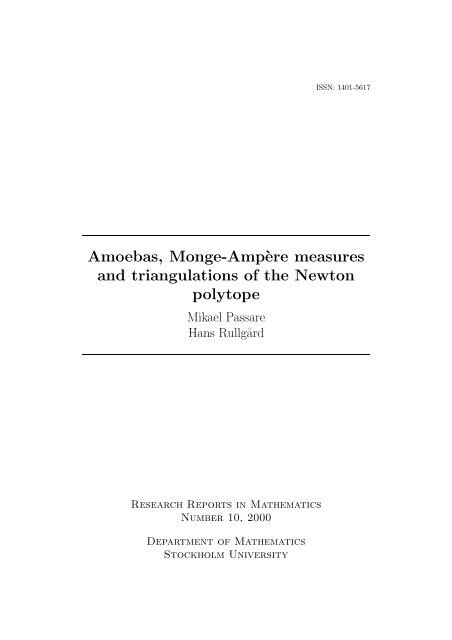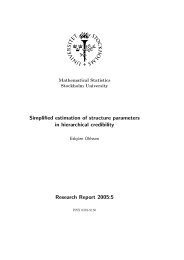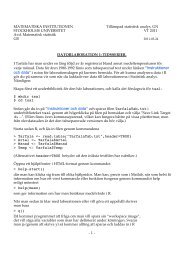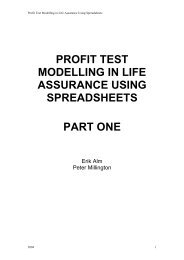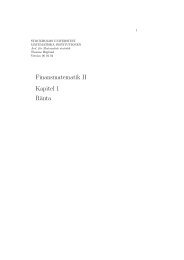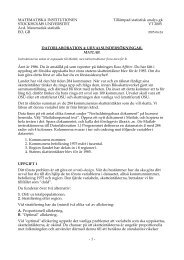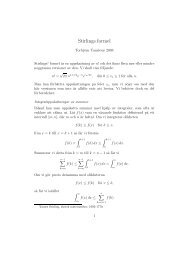Amoebas, Monge-Amp`ere measures and triangulations of the ...
Amoebas, Monge-Amp`ere measures and triangulations of the ...
Amoebas, Monge-Amp`ere measures and triangulations of the ...
You also want an ePaper? Increase the reach of your titles
YUMPU automatically turns print PDFs into web optimized ePapers that Google loves.
Electronic versions <strong>of</strong> this document are available athttp://www.matematik.su.se/reports/2000/10Date <strong>of</strong> publication: June 21, 20001991 Ma<strong>the</strong>matics Subject Classification: Primary 32A07 Secondary 32A05, 26A51,52B20.Postal address:Department <strong>of</strong> Ma<strong>the</strong>maticsStockholm UniversityS-106 91 StockholmSwedenElectronic addresses:http://www.matematik.su.seinfo@matematik.su.se
Pro<strong>of</strong>. The linear function c α +〈α, x〉 coincides with N f on an open set, hencec α + 〈α, x〉 ≤ N f (x) for all x. Taking <strong>the</strong> supremum over all α in A proves part(i). If E α denotes <strong>the</strong> component <strong>of</strong> Ω \ A f <strong>of</strong> order α, <strong>the</strong>nc α + 〈α, x〉 ≤ S(x) = N f (x) = c α + 〈α, x〉, for x ∈ E α ,which shows that E α ⊂ {α} ∗ . Since grad N f = β in E β we have a strictinequality c α + 〈α, x〉 < N f (x) = S(x) for x ∈ E β <strong>and</strong> all β ≠ α, whichimplies that E α = {α} ∗ \ A f . If x ∈ S f <strong>the</strong>n <strong>the</strong>re exist α, β ∈ A such thatx ∈ {α} ∗ ∩ {β} ∗ ⊂ Ω \ ⋃ γ≠α E γ \ ⋃ γ≠β E γ = A f . Finally we note that <strong>the</strong>connected components <strong>of</strong> Ω \ S f are precisely <strong>the</strong> sets {α} ∗ . Let us now turn to <strong>the</strong> question <strong>of</strong> how to compute <strong>the</strong> coefficients c α correspondingto a given Laurent polynomial f. If Γ is a face <strong>of</strong> <strong>the</strong> Newton polytope<strong>of</strong> f(z) = ∑ α∈C w αz α , where C denotes a finite subset <strong>of</strong> Z n , let f| Γ denote<strong>the</strong> truncation <strong>of</strong> f to Γ, that is f| Γ (z) = ∑ α∈Γ w αz α . It is well known thatwhen α ∈ Γ ∩ Z n , <strong>the</strong> complement <strong>of</strong> <strong>the</strong> amoeba <strong>of</strong> f has a component <strong>of</strong> orderα precisely if <strong>the</strong> complement <strong>of</strong> <strong>the</strong> amoeba <strong>of</strong> f| Γ does (see [3] Prop. 2.6 <strong>and</strong>also [4]).Proposition 2. Let f be a Laurent polynomial <strong>and</strong> let Γ be a face <strong>of</strong> <strong>the</strong> Newtonpolytope <strong>of</strong> f. If α ∈ Γ <strong>and</strong> <strong>the</strong> complement <strong>of</strong> A f has a component <strong>of</strong> order α,<strong>the</strong>n c α (f) = c α (f| Γ ). In particular, if α is a vertex <strong>of</strong> <strong>the</strong> Newton polytope <strong>of</strong>f, <strong>the</strong>n c α = log |w α |.Pro<strong>of</strong>. Take an outward normal v to <strong>the</strong> Newton polytope at Γ. If α ∈ Γ <strong>and</strong>x is in <strong>the</strong> component <strong>of</strong> R n \ A f <strong>of</strong> order α, it is known that x + tv is also inthat component for all t > 0. Thereforec α (f) − c α (f| Γ ) = 1(2πi)∫Log n logf(z)dz 1 . . . dz n∣−1 (x+tv) f| Γ (z) ∣ .z 1 . . . z n<strong>and</strong> here <strong>the</strong> integr<strong>and</strong> clearly tends to 0 when t → ∞. To fur<strong>the</strong>r describe <strong>the</strong> dependence <strong>of</strong> <strong>the</strong> coefficients c α on <strong>the</strong> polynomialf(z) = ∑ α∈C w αz α it is useful to introduce <strong>the</strong> functionsΦ α (w) = 1log(f(z)/z(2πi)∫Log α ) dz 1 . . . dz nn , (5)−1 (x) z 1 . . . z nwhere x is in <strong>the</strong> component <strong>of</strong> order α. This means that c α = Re Φ α . Noticethat Φ α is a holomorphic function in <strong>the</strong> coefficients w with values in C/2πiZ,defined whenever <strong>the</strong> complement <strong>of</strong> <strong>the</strong> amoeba <strong>of</strong> f has a component <strong>of</strong> orderα.Example. Suppose f(z) = (z + a 1 ) . . . (z + a N ) = w 0 + . . . + w N−1 z N−1 + z Nis a polynomial in one variable. Let 0 ≤ k ≤ N <strong>and</strong> assume that 0 < |a 1 |
. . . < |a k | < r < |a k+1 | < . . . < |a N |. Then one finds thatΦ k (w) = 1 ∫2πik∑∫==j=1N∑j=k+1|z|=r|z|=rlog(f(z)/z k )dzzlog((z + a j )/z)dzz+log a j = log(a k+1 . . . a N ).N∑j=k+1∫|z|=rlog(z + a j )dzzIn this case, we observe that Φ k (w) may be continued as a finitely branchedholomorphic function, whose branches correspond to various permutations <strong>of</strong><strong>the</strong> roots <strong>of</strong> f. Incidentally, <strong>the</strong> sum <strong>of</strong> all branches <strong>of</strong> exp Φ k (w) is equal to w k .We now return to <strong>the</strong> general case <strong>and</strong> show that <strong>the</strong> functions Φ α verynearly satisfy a system <strong>of</strong> GKZ hypergeometric equations. We remark that <strong>the</strong>functions Φ α , or ra<strong>the</strong>r ∂Φ α /∂w α were used in [2] in <strong>the</strong> study <strong>of</strong> constant termsin powers <strong>of</strong> Laurent polynomials. The main result was obtained by showing,essentially, that <strong>the</strong> second term in <strong>the</strong> representation (6) is non-constant alongevery complex line parallel to <strong>the</strong> w α axis, provided that α is not a vertex <strong>of</strong><strong>the</strong> Newton polytope <strong>of</strong> f.Theorem 2. Let f(z) = ∑ γ∈C w γz γ be a Laurent polynomial with C being afixed finite subset <strong>of</strong> Z n . Then <strong>the</strong> holomorphic functions Φ α have <strong>the</strong> powerseries expansionwhereΦ α (w) = log w α + ∑ (−k α − 1)!k∈K α∏β≠α k β! (−1)kα−1 w k , (6)K α = {k ∈ Z C ; k α < 0, k β ≥ 0 if β ≠ α, ∑ γk γ = 0, ∑ γγk γ = 0}. (7)The series converges for example when |w α | > ∑ β≠α |w β|. Moreover, Φ α satisfies<strong>the</strong> differential equations∑∑(∂ u − ∂ v )Φ α = 0 if (u γ − v γ ) = 0 <strong>and</strong> γ(u γ − v γ ) = 0 (8)γγ<strong>and</strong>∑w γ ∂ γ Φ α = 1 (9)γ∑γw γ ∂ γ Φ α = α. (10)γHere we have used <strong>the</strong> notation ∂ γ = ∂/∂w γ <strong>and</strong> ∂ u for u ∈ N C is <strong>the</strong> obviousmultiindex notation for a higher partial derivative.6
Pro<strong>of</strong>.∑Let M be an invertible n×n matrix with integer entries <strong>and</strong> let f(z) =∑α a αz α be any Laurent polynomial. Define a new Laurent polynomial Mf =α a αz Mα where a multiindex α is regarded as a column vector. It is notdifficult to show that <strong>the</strong> linear mapping x ↦→ M T x (where T denotes transpose)takes <strong>the</strong> amoeba <strong>of</strong> Mf onto <strong>the</strong> amoeba <strong>of</strong> f.Now let f be <strong>the</strong> special polynomial in <strong>the</strong> proposition <strong>and</strong> consider M whichmap <strong>the</strong> Newton polytope <strong>of</strong> f onto a translate <strong>of</strong> itself. The set <strong>of</strong> such Mcan be identified with <strong>the</strong> symmetric group S n+1 via its action on <strong>the</strong> vertices.Then Mf coincides with f up to an invertible factor, hence <strong>the</strong>y have <strong>the</strong> sameamoeba. In particular, M T maps <strong>the</strong> component <strong>of</strong> order (1, . . . , 1) in <strong>the</strong>complement <strong>of</strong> A f (if it exists) onto itself. If x is any point in that component,<strong>the</strong>n <strong>the</strong> convex hull <strong>of</strong> <strong>the</strong> points M T x, where M ranges over S n+1 , contains<strong>the</strong> origin. Since every component in <strong>the</strong> complement <strong>of</strong> <strong>the</strong> amoeba is convex,it follows that <strong>the</strong> component <strong>of</strong> order (1, . . . , 1) contains <strong>the</strong> origin. Conversely,if some component E contains <strong>the</strong> origin, <strong>the</strong>n M T E also contains <strong>the</strong> origin<strong>and</strong> hence coincides with E. This implies that E has order (1, . . . , 1).Now, <strong>the</strong> amoeba <strong>of</strong> f contains <strong>the</strong> origin precisely ifa = −(1 + z1 n+1 + . . . + znn+1 )/z 1 . . . z nwith |z 1 | = . . . = |z n | = 1, or equivalently,−a ∈ {t 0 + . . . + t n ; |t 0 | = . . . = |t n | = 1, t 0 . . . t n = 1}. We depict <strong>the</strong> sets K n for a few small values <strong>of</strong> n. Note that <strong>the</strong> cusps on <strong>the</strong>boundary correspond to polynomials with singular hypersurfaces.Figure 2: The sets K n for n = 2 <strong>and</strong> 3.Let us in particular consider <strong>the</strong> case n = 2. The coefficients c α are equal to0 when α is a vertex <strong>of</strong> <strong>the</strong> Newton polytope whilec (1,1) = log |a| + Re ∑ k>0(3k − 1)!(k!) 3 (−1) k−1 a −3kwhen |a| > 3, by Theorem 2. In fact it can easily be checked that <strong>the</strong> seriesconverges even when |a| = 3. What happens with <strong>the</strong> spine when a approaches<strong>the</strong> boundary <strong>of</strong> K 2 from <strong>the</strong> outside? For example, when a → −3 a numerical8
˜M(u 1 , . . . , u n ) is a positive measure which depends multilinearly on <strong>the</strong> argumentsu j . We call ˜M <strong>the</strong> mixed real <strong>Monge</strong>-Ampère operator.The real <strong>Monge</strong>-Ampère operator is related to its complex counterpart asfollows. Suppose u 1 , . . . , u n are smooth convex functions on <strong>the</strong> domain Ω.Let U 1 , . . . , U n be plurisubharmonic functions on Log −1 (Ω) defined by U j (z) =u j (Log z). Then∫∫n! ˜M(u 1 , . . . , u n ) = dd c U 1 ∧ . . . ∧ dd c U n (12)ELog −1 (E)where d c = (∂ − ¯∂)/2πi. This remains true if one <strong>of</strong> <strong>the</strong> functions U j , say U 1 , isallowed to be an arbitrary smooth plurisubharmonic function in Log −1 (Ω), u 1being defined byu 1 (x) = 1U 1 (z)dz 1 . . . dz n(2πi)∫Log n .−1 (x) z 1 . . . z nMore generally, if U 1 , . . . , U n are arbitrary smooth plurisubharmonic functionson Log −1 (Ω), <strong>and</strong><strong>the</strong>n∫n!E˜M(u 1 , . . . , u n ) =u j (x) = 1U j (z)dz 1 . . . dz n(2πi)∫Log n (13)−1 (x) z 1 . . . z n∫T n2 ∫dd c U 1 (t (1) z) ∧ . . . ∧ dd c U n (t (n) z)dλ(t).Log −1 (E)(14)Here T n2 denotes <strong>the</strong> real n 2 -dimensional torus {t = (t (k)j ); |t (k)j | = 1, j, k =1, . . . n} equipped with <strong>the</strong> usual normalized Haar measure λ, <strong>and</strong> each t (k) =(t (k)1 , . . . , t(k) n ) acts on C n by componentwise multiplication. These formulascan be checked by direct computation. A pro<strong>of</strong> <strong>of</strong> (12) when u 1 = . . . =u n can be found in [6]. The general case follows by polarization since bothsides are multilinear. Formula (14) follows by reversing <strong>the</strong> order <strong>of</strong> integrationon <strong>the</strong> right. Since <strong>the</strong> inner integral is constant along certain n dimensionalsubmanifolds <strong>of</strong> T n2 it is actually possible to omit some <strong>of</strong> <strong>the</strong> variables in <strong>the</strong>outer integration. This also proves <strong>the</strong> generalised version <strong>of</strong> (12) with U 1 anarbitrary smooth plurisubharmonic function.Theorem 4. Let E be any Borel set in Ω, <strong>and</strong> let ∆ denote <strong>the</strong> Laplace operator.Then∫ ∫(n − 1)! ∆N f =ω n−1ELog −1 (E)∩f −1 (0)where ω = (|z 1 | −2 d¯z 1 ∧ dz 1 + . . . + |z n | −2 d¯z n ∧ dz n )/2πi.Pro<strong>of</strong>. If u is any convex function, <strong>the</strong>n ∆u = n ˜M(u, |x| 2 , . . . , |x| 2 ) <strong>and</strong> ω =dd c | Log z| 2 . Since dd c log |f| is equal to <strong>the</strong> current <strong>of</strong> integration along f −1 (0)it follows from (12) that∫∫n! ∆N f = n dd c log |f| ∧ ω n−1E∫= nLog −1 (E)Log −1 (E)∩f −1 (0)ω n−1 .10
The following <strong>the</strong>orem can be thought <strong>of</strong> as a local analog <strong>of</strong> Bernstein’s<strong>the</strong>orem [1] relating <strong>the</strong> number <strong>of</strong> solutions to a system <strong>of</strong> polynomial equationsto <strong>the</strong> mixed volume <strong>of</strong> <strong>the</strong>ir Newton polytopes.Theorem 5. Let f 1 , . . . , f n be holomorphic functions in Log −1 (Ω) <strong>and</strong> let E ⊂Ω be a Borel set. Then n! ˜M(N f1 , . . . , N fn )(E) is equal to <strong>the</strong> average number<strong>of</strong> solutions in Log −1 (E) to <strong>the</strong> system <strong>of</strong> equationsas t = (t (j)kf j (t (j)1 z 1, . . . , t (j)n z n ) = 0 j = 1, . . . , n (15)) ranges over <strong>the</strong> torus {t; |t(j) | = 1, j, k = 1, . . . , n}.kPro<strong>of</strong>. If U j are smooth plurisubharmonic functions which converge to log |f j |,<strong>the</strong>n u j defined by (13) converge to N fj . By <strong>the</strong> general properties <strong>of</strong> <strong>the</strong> real<strong>Monge</strong>-Ampère operator this implies that ˜M(u1 , . . . , u n ) converges weakly to˜M(N f1 , . . . , N fn ). Also dd c U 1 (t (1) z) ∧ . . . ∧ dd c U n (t (n) z) converges weakly to<strong>the</strong> sum <strong>of</strong> point masses at <strong>the</strong> solutions <strong>of</strong> f 1 (t (1) z) = . . . = f n (t (n) z) = 0.Hence <strong>the</strong> <strong>the</strong>orem follows by passing to <strong>the</strong> limit in (14) if we only show that∫dd c U 1 (t (1) z) ∧ . . . ∧ dd c U n (t (n) z)Log −1 (E)remains uniformly bounded as U j → log |f j |. Here we may assume that E iscompact <strong>and</strong> that U j is <strong>of</strong> <strong>the</strong> form U j = ψ(|f j |) where ψ will converge to log.Let f t (z) = (f 1 (t (1) z), . . . , f n (t (n) z)). Then f t (z) is a holomorphic functionin z <strong>and</strong> t defined for z in a neighbourhood <strong>of</strong> Log −1 (E) <strong>and</strong> t in a complexneighbourhood <strong>of</strong> T n2 . Using compactness arguments it is not difficult to showthat <strong>the</strong>re exists a constant C such that <strong>the</strong> number <strong>of</strong> solutions in Log −1 (E)to <strong>the</strong> equation f t (z) = w is bounded above by C for almost all t ∈ T n2 <strong>and</strong>w ∈ C n . Since η = dd c ψ(|w 1 |) ∧ . . . ∧ ψ(|w n |) induces a positive measure on C nwith total mass 1, it follows that∫0 ≤ ft ∗ η ≤ C<strong>and</strong> this completes <strong>the</strong> pro<strong>of</strong>. EIf E is a compact component <strong>of</strong> A f1 ∩ . . . ∩ A fn , <strong>the</strong>n for topological reasons,<strong>the</strong> number <strong>of</strong> solutions to (15) in Log −1 (E) does not depend on t. Hence weobtain <strong>the</strong> following corollary.Corollary 1. Suppose K is a compact component <strong>of</strong> A f1 ∩ . . . ∩ A fn . Thenn! ˜M(N f1 , . . . , N fn )(K) is a positive integer, which is equal to <strong>the</strong> number <strong>of</strong>solutions <strong>of</strong> <strong>the</strong> system f 1 (z) = . . . = f n (z) = 0 in Log −1 (K).Let us now see what <strong>the</strong> measure µ f looks like in some specific cases. First, ifn = 1, <strong>the</strong> amoeba is a discrete point set <strong>and</strong> µ f is a sum <strong>of</strong> point masses. Moreprecisely, µ f ({x}) is equal to <strong>the</strong> number <strong>of</strong> zeros <strong>of</strong> f on <strong>the</strong> circle log |z| = x. In<strong>the</strong> case <strong>of</strong> two variables <strong>the</strong>re is an interesting estimate on <strong>the</strong> <strong>Monge</strong>-Ampèremeasure.Theorem 6. Let f be a holomorphic function in two variables defined on acircular domain Log −1 (Ω). Then µ f is greater than or equal to π −2 timesLebesgue measure on <strong>the</strong> amoeba <strong>of</strong> f.11
Pro<strong>of</strong>. We prove <strong>the</strong> inequality in a neighbourhood <strong>of</strong> a point x ∈ A f whereLog −1 (x) intersects f −1 (0) transversely in a finite number <strong>of</strong> points. Since thisis true for almost all x it will establish <strong>the</strong> inequality.Write log z j = x j + iy j for j = 1, 2 <strong>and</strong> assume that <strong>the</strong> hypersurface f −1 (0)is given locally as <strong>the</strong> union <strong>of</strong> graphs y = φ k (x). We shall express <strong>the</strong> Hessian<strong>of</strong> N f in terms <strong>of</strong> <strong>the</strong> functions φ k .Differentiating <strong>the</strong> integral (1) defining N f with respect to x 1 we obtain∂N f∂x 11∂f/∂z 1 dz 1 dz 2= Re(2πi)∫Log 2 −1 (x) f(z)z 2= 1 ∫n(f(·, z 2 ), x 1 ) dz 22πi log |z 2|=x 2z 2= 12π∫ 2π0n(f(·, e x2+iy2 ), x 1 )dy 2 .Here n(f(·, z 2 ), x 1 ) is <strong>the</strong> number <strong>of</strong> zeros minus <strong>the</strong> number <strong>of</strong> poles <strong>of</strong> <strong>the</strong>function z 1 ↦→ f(z 1 , z 2 ) inside <strong>the</strong> disc {log |z 1 | < x 1 } provided that it is meromorphicin that domain. In general, n(f(·, z 2 ), x 1 ) − n(f(·, z 2 , x ′ 1) is equal to<strong>the</strong> number <strong>of</strong> zeros in <strong>the</strong> annulus {x ′ 1 < log |z 1| < x 1 } when x ′ 1 < x 1. Theintegr<strong>and</strong> in <strong>the</strong> last integral is a piecewise constant function with a jump <strong>of</strong>magnitude 1 at y 2 = φ k,2 (x). It follows that <strong>the</strong> gradient <strong>of</strong> ∂N f /∂x 1 is given bya sum <strong>of</strong> terms ±(2π) −1 grad φ k,2 . The correct sign <strong>of</strong> each term can be foundby observing that n(f(·, e x2+iy2 ), x 1 ) is increasing as a function <strong>of</strong> x 1 , hence all<strong>the</strong> terms contributing to ∂ 2 N f /∂x 2 1 should be positive. A similar computationapplies to ∂N f /∂x 2 .Assume now that f −1 (0) is given locally by an equationa log z 1 + b log z 2 + higher terms = constant.Solving for y in this equation yields that( )∂φ k∂x = 1 Re(a¯b) |b|2Im(a¯b) −|a| 2.− Re(a¯b)The crucial observation here is that( )∂φk,2 /∂x±1 ∂φ k,2 /∂x 2−∂φ k,1 /∂x 1 −∂φ k,1 /∂x 2(16)is a positive definite matrix with determinant 1, <strong>and</strong> that 2π Hess(N f ) is a sum<strong>of</strong> such matrices.The inequality now follows from <strong>the</strong> following lemma since Log −1 (x) intersectsf −1 (0) in at least two points for generic x in A f . Lemma. If A 1 , A 2 are 2 × 2 positive definite matrices, <strong>the</strong>n det(A 1 + A 2 ) ≥det A 1 + det A 2 + 2 √ det A 1 det A 2 . Equality holds if <strong>and</strong> only if A 1 <strong>and</strong> A 2 arereal multiples <strong>of</strong> one ano<strong>the</strong>r.Pro<strong>of</strong>. To see this, write A j = ( a j b j)b j c j<strong>and</strong> apply <strong>the</strong> Cauchy-Schwarz inequalityto <strong>the</strong> vectors (b j , a j c j − b 2 j ) to obtain b 1b 2 + √ det A 1 det A 2 ≤ √ a 1 a 2 c 1 c 2√.12
Then it follows that det(A 1 + A 2 ) − det A 1 − det A 2 = a 1 c 2 + c 1 a 2 − 2b 1 b 2 ≥2 √ a 1 a 2 c 1 c 2 − 2b 1 b 2 ≥ 2 √ det A 1 det A 2 . The conditions for equality are that(b 2 1, a 1 c 1 − b 2 1) is proportional to (b 2 2, a 2 c 2 − b 2 2) <strong>and</strong> that (a 1 , c 1 ) is proportionalto (a 2 , c 2 ) which clearly is equaivalent to A 1 being proportional to A 2 . As an immediate consequence <strong>of</strong> Theorem 3 <strong>and</strong> Theorem 6 we have <strong>the</strong>following estimate.Corollary 2. Let f be a Laurent polynomial in two variables. Then <strong>the</strong> area <strong>of</strong><strong>the</strong> amoeba <strong>of</strong> f is not greater than π 2 times <strong>the</strong> area <strong>of</strong> <strong>the</strong> Newton polytope <strong>of</strong>f.On <strong>the</strong> contrary, when n ≥ 3 <strong>the</strong> volume <strong>of</strong> <strong>the</strong> amoeba <strong>of</strong> a polynomial isalmost always infinite.Example. As an illustration <strong>of</strong> <strong>the</strong> last <strong>the</strong>orem we consider <strong>the</strong> polynomialsf(z 1 , z 2 ) = f a (z 1 , z 2 ) = a + z 1 + z 2 + z 1 z 2 where a is assumed to be a realnumber.We want to compute <strong>the</strong> number <strong>of</strong> points in Log −1 (x) ∩ f −1 (0) for a givenpoint x ∈ R n . For points z in this set it must hold that |a + z 1 | = |1 + z 1 |e x2 .Conversely, if this equation holds, <strong>the</strong>n (z 1 , (a + z 1 )/(1 + z 1 )) is in this set. Ifθ = arg z 1 , <strong>the</strong> equation can be rewritten 2e x 1 (e2x2 −a) cos θ = a 2 +e 2x1 −e 2x2 −e 2x1+2x2 . From this it follows immediately that <strong>the</strong> amoeba <strong>of</strong> f is defined by<strong>the</strong> inequality 4e 2x1 (e 2x2 − a) 2 ≥ (a 2 + e 2x1 − e 2x2 − e 2x1+2x2 ) 2 . Moreover, <strong>the</strong>following can be deduced when we assume that a ≠ 1. If x is in <strong>the</strong> interior<strong>of</strong> <strong>the</strong> amoeba, <strong>the</strong>n Log −1 (x) ∩ f −1 (0) has precisely two points. If x is in <strong>the</strong>boundary <strong>of</strong> <strong>the</strong> amoeba, <strong>and</strong> not equal to (log a, log a)/2 when a is positive,<strong>the</strong>n Log −1 (x) ∩ f −1 (0) has exactly one point. If a > 0 <strong>and</strong> x = (log a, log a)/2,<strong>the</strong>n Log −1 (x) ∩ f −1 (0) contains a real curve.By <strong>the</strong> preceding <strong>the</strong>orem, µ f is greater than or equal to π −2 times <strong>the</strong>Lebesgue measure on <strong>the</strong> amoeba <strong>of</strong> f. Assume now that a < 0. For x in <strong>the</strong>interior <strong>of</strong> A f , 2π Hess(N f ) is a sum <strong>of</strong> two matrices <strong>of</strong> <strong>the</strong> form (16). Since fhas real coefficients it follows that φ 1 = −φ 2 , hence <strong>the</strong> two matrices are equal.This means that all inequalities in <strong>the</strong> pro<strong>of</strong> <strong>of</strong> Theorem 6 actually becomeequalities. It follows also from Theorem 5 that µ f has no mass on <strong>the</strong> boundary<strong>of</strong> <strong>the</strong> amoeba. Hence <strong>the</strong> area <strong>of</strong> <strong>the</strong> amoeba is equal to π 2 .When a is positive <strong>and</strong> not equal to 1, <strong>the</strong> same conciderations hold awayfrom <strong>the</strong> special point (log a, log a)/2. On <strong>the</strong> o<strong>the</strong>r h<strong>and</strong>, <strong>the</strong> amoeba <strong>of</strong> f ais strictly smaller than <strong>the</strong> amoeba <strong>of</strong> f −a . The remaining mass <strong>of</strong> µ fa , whichmust have <strong>the</strong> same total mass as µ f−a resides as a point mass at (log a, log a)/2.In <strong>the</strong> particular case a = 1, <strong>the</strong>re is a factorization f(z) = (z 1 + 1)(z 2 + 1)<strong>and</strong> <strong>the</strong> amoeba consists <strong>of</strong> <strong>the</strong> two lines {x 1 = 0} <strong>and</strong> {x 2 = 0}. The <strong>Monge</strong>-Ampère measure µ f <strong>the</strong>n degenerates into a single point mass at <strong>the</strong> intersectionpoint <strong>of</strong> <strong>the</strong> two lines.References[1] David Bernstein: The number <strong>of</strong> roots <strong>of</strong> a system <strong>of</strong> equations, FunctionalAnal. Appl. 9 (1975), 183 - 185.13
Figure 3: The amoebas <strong>of</strong> a + z 1 + z 2 + z 1 z 2 for a = −5 <strong>and</strong> a = 5.[2] Johannes Duistermaat, Wilberd van der Kallen: Constant terms in powers<strong>of</strong> a Laurent polynomial, Indag. Math. 9 (1998), 221 - 231.[3] Mikael Forsberg, Mikael Passare, August Tsikh: Laurent determinants <strong>and</strong>arrangements <strong>of</strong> hyperplane amoebas, Adv. in Math. 151 (2000), 45 - 70.[4] Israel Gelf<strong>and</strong>, Mikhail Kapranov, Andrei Zelevinsky: Discriminants, resultants<strong>and</strong> multidimensional determinants, Birkhäuser, Boston, 1994.[5] Grigory Mikhalkin: Real algebraic curves, moment map <strong>and</strong> amoebas,Manuscript, Harvard University, 1998. (To appear in Ann. <strong>of</strong> Math.)[6] Alex<strong>and</strong>er Rashkovskii: Indicators for plurisubharmonic functions <strong>of</strong> logarithmicgrowth. Available at http://xxx.lanl.gov/abs/math/9911240[7] Jeffrey Rauch, Alan Taylor: The Dirichlet problem for <strong>the</strong> multidimensional<strong>Monge</strong>-Ampère equation, Rocky Mountain J. Math. 7 (1977), 345 -364.[8] Lev Ronkin: On zeros <strong>of</strong> almost periodic functions generated by holomorphicfunctions in a multicircular domain, To appear in “Complex Analysisin Modern Ma<strong>the</strong>matics”, Fazis, Moscow, 2000, pp. 243-256.[9] Lev Ronkin: Introduction to <strong>the</strong> <strong>the</strong>ory <strong>of</strong> entire functions <strong>of</strong> several variables,Translations <strong>of</strong> ma<strong>the</strong>matical monographs, AMS, Providence, 1974.14


